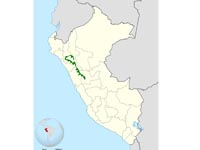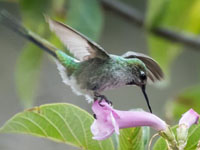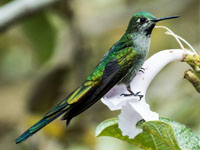Hummingbirds are restricted to the Americas from southern Alaska to Tierra del Fuego, including the Caribbean. The majority of species occur in tropical and subtropical Central and South America. Hummingbirds are are among the smallest of birds. They can hover in mid-air by rapidly flapping their wings 12–90 times per second (depending on the species). They can also fly backwards, and are the only group of birds able to do so. They can fly at speeds exceeding 50 km/h (30 mi/h).
Hummingbirds drink nectar, a sweet liquid inside flowers. Nectar is a poor source of nutrients, so they also prey on insects and spiders, especially when feeding young. When hummingbirds feed on nectar, the bill is usually only opened slightly, allowing the tongue to dart out and into the interior of flowers. Most hummingbirds have bills that are long and straight or nearly so, but in some species the bill shape is adapted for specialized feeding. Hummingbirds do not spend all day flying, as the energy cost would be prohibitive; the majority of their activity consists simply of sitting or perching. With the exception of insects, hummingbirds while in flight have the highest metabolism of all animals, a necessity in order to support the rapid beating of their wings. Their heart rate can reach over 1000 beats per minute.
The hummingbirds are presented in 7 web pages: 1) Barbthroat, Hermit, Jacobian, Sicklebill, Topaz
2) Carib, Fairy, Goldenthroat, Mango, Violetear, Visorbearer 3) Comet, Coquette, Firecrown, Sunangel, Sylph, Thorntail
4) Helmetcrest, Hillstar, Metaltail, Puffleg, Thornbill 5) Brilliant, Coronet, Inca, Starfrontlet, Sunbeam
6) Mountain-gem, Starthroat, Sheartail, Woodstar 7) Emerald, Plumeleteer, Sabrewing, Woodnymph
Comet, Coquette, Firecrown, Sunangel, Sylph, Thorntail
Genus Adelomyia - 1 species
Hummingbird,_Speckled Adelomyia melanogenys Found: Andes from Venezuela to Argentina
The Speckled Hummingbird has black cheek patch, bordered above by white stripe; pale underparts with some freckles.
Image by: 1, 2, 3) Jerry Oldenettel - Ecuador 4, 5, 6) Nick_Athanas - Peru, Peru, Ecuador4) A. m. chlorospila 5) A . m. melanogenys 6) A. m. maculata
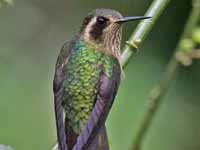
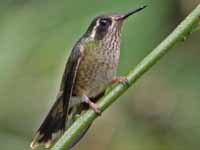
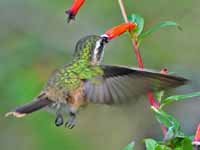

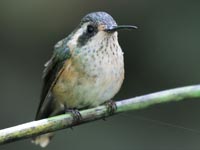
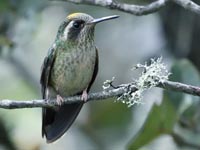
Genus Aglaiocercus
Sylphs have short bills and males have very long tails.
Sylph,_Long-tailed Aglaiocercus kingii Found: east slope of Andes from Venezuela to Bolivia
The male long-tailed Sylph has blue-green wings and very long tail; green rest of upperparts; glittering green crown, throat. Female has white throat speckled with green; tawny-buff belly; tail not long.
Image by: 1) Felix_Uribe 2) Julian_Londono - Columbia 3) Alejandro_Tamayo 4) Dick Daniels - Guango Lodge, Ecuador 5) Nick_Athanas - Ecuador 6) Andy_Morffew - Ecuador1. 2) Female 4 - 6) Male
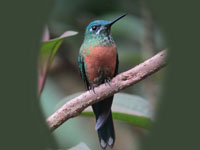
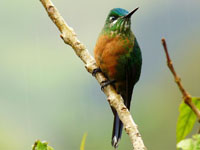
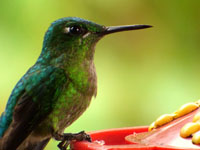


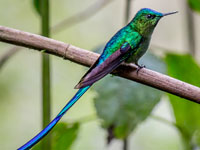
Sylph,_Venezuelan Aglaiocercus berlepschi Found: Venezuela
The male Venezuelan Sylph has mainly green plumage; very long blue than violet tail; blue gorget. Female has mainly green upperparts; whitish underparts with green spots; tail not long.
Image by: 1) Nick_Athanas 2) Barloventomagico1) Female 2) Male
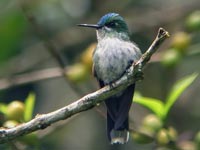

Sylph,_Violet-tailed Aglaiocercus coelestis Found: Columbia, Ecuador
The male Violet-tailed Sylph have very long purple tail with blue tips. Once considered subspecies of Long-tailed Sylph.
Image by: 1) Cephas 2, 4) Sergey_Pisarevskiy Nick_Athanas - Ecuador 5) Michael_Woodruff - Ecudor 6) Andy_Morffew - Ecuador2, 3) Female 4, 5, 6) Male

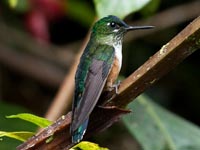
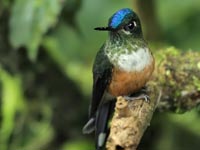
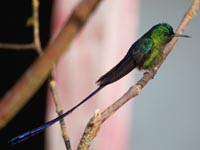


Genus Anthocephala
Blossomcrown,_Santa_Marta Anthocephala floriceps Found: Santa Marta moutains of Columbia
The Santa Marta Blossomcrown has green upperparts; buff white forehead; orange hind-crown; dull gray underparts.
Image by: 1) Cornell_Univ's_Neotropical_Birds_Online - Juan_Joe_Arango 2) Nick_Athanas - Columbia

Blossomcrown,_Tolima Anthocephala berlepschi Found: northeast Columbia
The Tolima Blossomcrown was considered a subspecies of the Santa Marta Blossomcrown until 2015.
Image by: 1, 2) Cornell_Univ's_Neotropical_Birds_Online - Hugo_Loaiza, ProAves_Colombia 3) Nick_Athanas

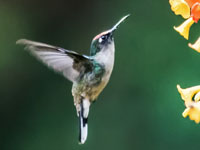
Genus Discosura
Some have argued for merging the Thorntails into the Coquettes (Lophornis), which they overall resemble, except for the highly modified tail-feathers of the males.
Coquette,_Racket-tailed Discosura longicaudus Found: northern South America
The male Racket-tailed Coquette has black "rackets" on outermost tail feathers; buffy rump band.
Image by: 1) Cephas 2) _Nick_Athanas - Guyana 3, 4) Thelma_Gatuzzo Cornell_Univ's_Neotropical_Birds_Online - Lars_Petersson, Carlos_Gussoni 2) Female or juvenile male 3) Female 4) Male
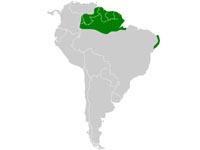


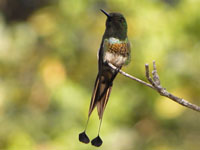
Thorntail,_Black-bellied Discosura langsdorffi Found: Bolivia, Brazil, Colombia, Ecuador, Peru, Venezuela
The male Black-bellied Thorntail has green gorget; narrow rufous band below; black breast.
Image by: 1) Chephas 2, 3) Cornell_Univ's_Neotropical_Birds_Online - Peter_Hawrylyshyn, Daniel_Lane 4) Nick_Athanas - Peru2) Female 3, 4) Male



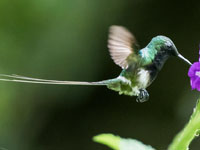
Thorntail,_Green Discosura conversii Found: Costa Rica to Ecuador
The Green Thorntail has mainly green upperparts; white rump band; blackish lower rump, tail. Male has long wire-like tail.
Image by: 1) Cephas 2) Sylvere_Corre - Ecuador 3) Nick Athanas 4) Jerry_Oldenettel - Ecuador2, 3) Female 4) Male
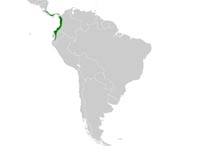

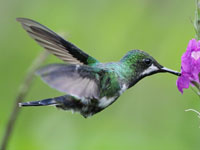

Thorntail,_Wire-crested Discosura popelairii Found: Columbia, Ecuador, Peru
The Wire-crested Thorntail has green back; white rump band. Male has long blue forked tail, wire-crest on head. Female has white lores, belly.
Image by: 1) Cephas 2, 4) Laura Gaudette 3, 5) Nick_Athanas - Peru 6) Ameet - Peru 2, 3) Female 4- 6) Male





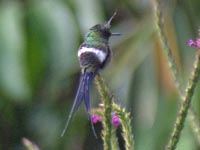
Genus Heliangelus
Sunangles are found in humid forests, forest edges, and scrub zones of the Andes.
Sunangel,_Amethyst-throated Heliangelus amethysticollis Found: Bolivia, Columbia, Ecuador, Peru, Venezuela
The male Amethyst-throated Sunangel has a purple gorget; whitish cresent across breast. Female may have whitish cresent across breast; dull brown, rufous brown, or purple gorget.
Image by: 1) Cephas 2) Claudio_Timm 3, 5) Nick_Athanas - Ecuador 4) Francesco Veronesi - Ecuador2, 3) Female 5) Male
3) H. a. laticlavius
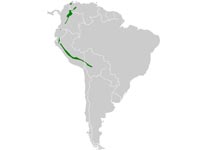
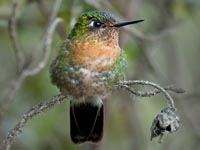

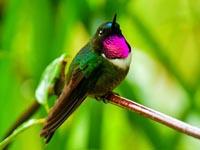
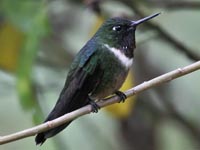
Sunangel,_Gorgeted Heliangelus strophianus Found: mainly Ecuador; also adjacent Columbia
The Gorget Sunangle has white breast band. Male has pink gorget; female has little pink on throat.
Image by: 1) Cephas 2) Ameet - Ecuador 3) Nick_Athanas - Ecuador 4) Carlos_Henrique - Ecuador2) Female 3, 4) Male

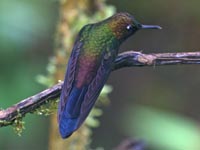

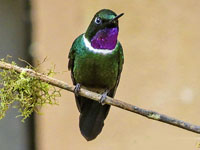
Sunangel,_Little also Flame-throated Sunangel Heliangelus micraster Found: Ecuador, Peru
The Little Sunangle has flaming orange gorget; females is smaller and may show blend of white and green.
Image by: 1) Cephas 2, 3, 4) Nick_Athanas - Ecuador2) Juvenile 3) Female or subadult male 4) Male
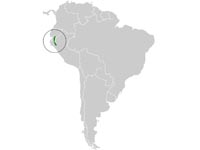
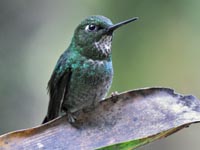
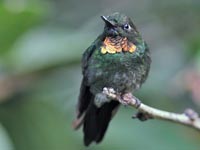
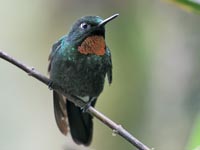
Sunangel,_Orange-throated Heliangelus mavors Found: Columbia, Venezuela
The male Orange-throated Sunangle has orange gorget in good light, but gorget can be blackish in poor light. Both sexes have buffy breast crescent.
Image by: 1) Cephas 2) Andy_Jones 3) Nick_Athanas 4) Barloventomagico - Venezuela2) Female 3, 4) Male
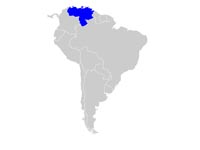
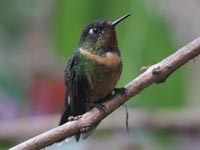
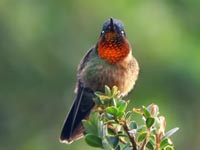
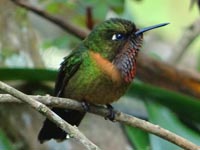
Sunangel,_Purple-throated Heliangelus viola Found: Ecuador, Peru
The Purple-throated Sunangle has shining green plumage. Male has purple gorget.
Image by: 1) Cephas 2, 3, 4) Dick Daniels - Ecuador 5, 6) Nick_Athanas - Ecuador2 - 5) Female 6) Male
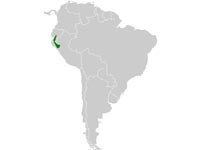
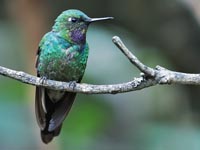




Sunangel,_Royal Heliangelus regalis Found: Mainly Peru; also Ecuador
The male Royal Sunangle has deep blue pluamage tending to black on head. Female has dark green upperparts; green spotted cinnamon underparts with pale breast-band.
Image by: 1) Cephas 2) Cornell_Univ's_Neotropical_Birds_Online - Peter_Hawrylyshyn 3) Nick_Athanas - Peru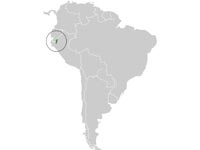


Sunangel,_Tourmaline Heliangelus exortis Found: Columbia, Ecuador
The male Tourmaline Sunangel has violet-blue chin; magenta lower throat. Female has whitish throat with spotting.
Image by: 1) Cephas 2, 3, 4, 5, 6, 7, 8) Dick Daniels - Guango Lodge, Ecuador 9) Andy_Morffew2 - 6) Female 7 - 9) Male
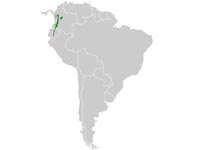







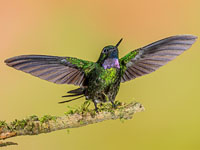
Genus Lophornis
Coquette,_Black-crested Lophornis helenae Found: Mexico to Costa Rica
The male Black-crested Coquette has green throat, crown; whsipy black crest; bronzy breast band; elongated black and buff cheek feathers. Female lacks green throat, crest, eleongated cheek feathers. Both have pale rump band.
Image by: 1) Amy_McAndrews - Costa Rica 2) Nick_Athanas - Costa Rica 3) Jerry_Oldenettel - Costa Rica1) Female 2, 3) Male


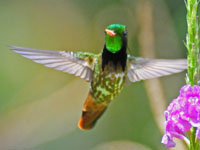
Coquette,_Dot-eared Lophornis gouldii Found: mainly Brazil; also Bolivia
The Dot-eared Coquette has green-spotted white cheek tufts; more obvious in males than females. Female has rufous throat patch.
Image by: 1) Dave_Curtis - Brazil1) Female 2) Male
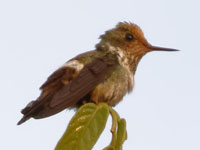
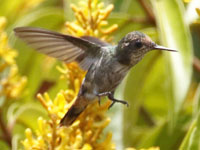
Coquette,_Festive Lophornis chalybeus Found: Bolivia, Brazil, Columbia, Ecuador, Peru, Venezuela
The male Festive Coquette has green cheek tufts tipped with white; Both sexes have white rump-band.
Image by: 1) Chephas 2, 5) Nick_Athanas - Ecuador, Brazil 3, 4) Dario Sanches - Brazil1) Juvenile 2, 3) Female 4, 5) Male
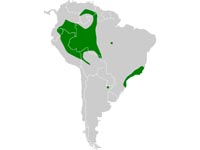
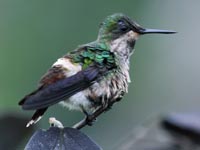
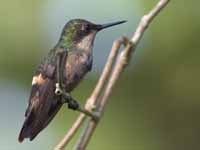
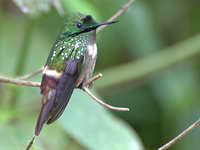

Coquette,_Frilled Lophornis magnificus Found: Brazil
The Frilled Coquette has coppery-green upperparts; whitish rump band; golden-rufous tail; whitish-green underparts. Male has long rufous-orange erectile crest; iridescent green forehead, throat; white fan-shaped cheek feathers.
Image by: 1) Cephas 2, 4) Nick_Athanas 3) Baraodorio Hector_Bottai2) Female 3, 4, 5) Male

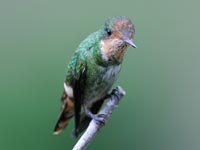
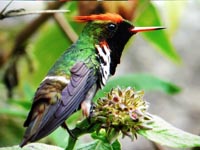


Coquette,_Peacock Lophornis pavoninus Found: mainly Venezuela; also Brazil, Guyana
The male Peacock Coquette has broad green and black throat tufts.
Image by: 1) Cephas 2) Jerry_Oldenettel - Venezuela 3) Cornell_Univ's_Neotropical_Birds_Online - Lars_Petersson in Venezuela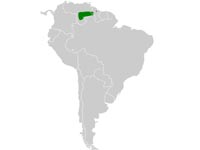
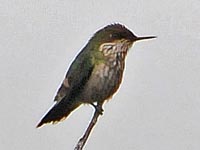
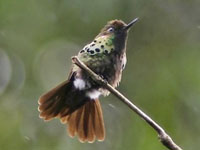
Coquette,_Rufous-crested Lophornis delattrei Found: Panama, Bolivia, Columbia, Ecuador, Peru
The male Rufous-crested Coquette's striking, elongated, rufous crest is more spiky than the bushy crest of the Spangled Coquette, and females are potentially distinguished by the bronzy green underparts.
Image by: 1) Nick_Athanas - Peru 3) Dominic_Sherony - Panama 2, 4) Cornell_Univ's_Neotropical_Birds_Online - Peter_Hawrylyshyn in Peru, Jean_Paul_Perret in Peru1) Pair 2) Female 3, 4) Male
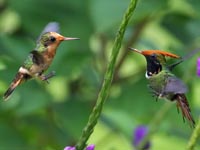

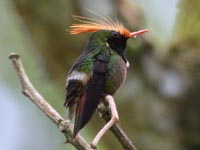
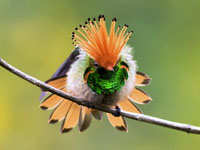
Coquette,_Short-crested Lophornis brachylophus Found: Mexico
The Short-crested Coquette is present perhaps only along a 25 kilometer section of the Atoyac-Paraíso-Puerto del Gallo road in the Sierra Madre del Sur of Mexico.
Image by: 1) Cephas 2, 3) Cornell_Univ's_Neotropical_Birds_Online - Stephen_Davies, Ryan_Shaw


Coquette,_Spangled Lophornis stictolophus Found: Colombia, Ecuador, Peru, Venezuela
The rufous crest of the male Spangled Coquette is bushy than the Rufous-crested Coquette (which has a spiky crest) and is speckled with black dots. Females exhibit whiter throats.
.
Image by: 1) Cephas 2) Tony_Castro 3) Francesco_Veronesi - Ecuador 4) Cornell_Univ's_Neotropical_Birds_Online - Jean_Margareta_Wieser .

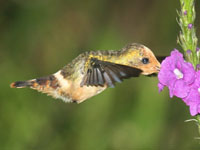

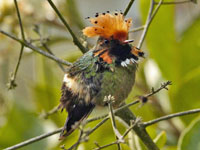
Coquette, Tufted Lophornis ornatus Found: extreme ne Brazil; the Guianas, Suriname, Venezuela
The male Tufted Coquette has broad rufous-and-black throat tufts; orange crest.
Image by: 1) New Jersy Birds 2, 3) Steve Garvie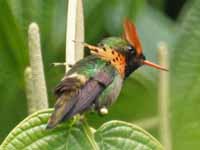
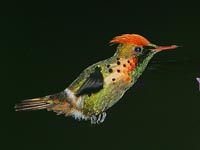
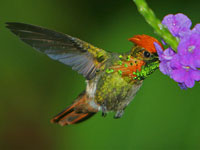
Coquette,_White-crested Lophornis adorabilis Found: Costa Rica, Panama
The White-crested Coquette has rufous on lower breast, belly. Male has white crest; shiny green cheek tufts.
Image by: 1) Cephas 2) coffeetaylor - Panama 3) Feroze_Omardeen - Costa Rica Cornell_Univ's_Neotropical_Birds_Online - Chris_Jimenez2) Female 3, 4) Male

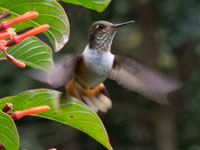
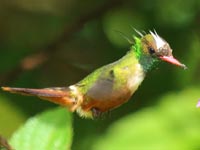

Genus Phlogophilus
Piedtail,_Ecuadorian Phlogophilus hemileucurus Found: mainly Ecuador; also Columbia, Peru
The Ecuadorian Piedtail has white band at base of tail and white have at end of tail; white breast band.
Image by: 1) Cephas 2) Nick_Athanas - Ecuador 3) Cornell_Univ's_Neotropical_Birds_Online - Glenn_Bartley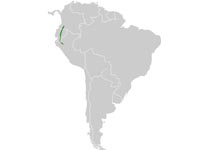
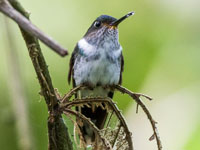

Piedtail,_Peruvian Phlogophilus harterti Found: Peru
The Peruvian Piedtail has green upperparts; buffy underparts with white breast band.
Image by: 1) Cephas 2, 3) Cornell_Univ's_Neotropical_Birds_Online - Jean-Luc_Baron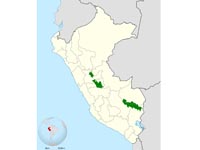

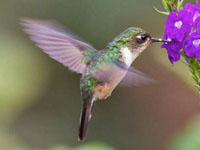
Genus Polyonymus
Comet,_Bronze-tailed Polyonymus caroli Found: Peru
The Bronze-tailed Comet has dingy bronze-green upperparts; paler underparts; rosy gorget. Male has slightly longer tail.
Image by: 1) Cephas 2) Cornell_Univ's_Neotropical_Birds_Online - Dusan_Brinkhuizen2) Male
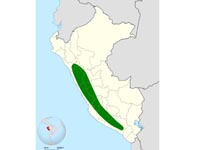
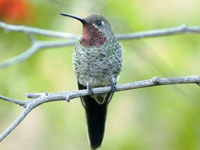
Comet,_Red-tailed Sappho sparganurus Found: Argentina, Bolivia
The Red-tailed Comet has reddish-violet back, rump; green head. Male has shining green gorget; long golden-reddish tail. Female has shorter reddish-bronze tail.
Image by: 1) Cephas 2, 3, 4) Nick_Athanas - Argentina2) Female 3, 4, 5) Male
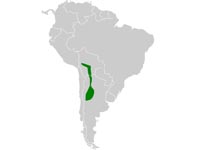



Genus Sephanoides
Firecrown,_Green-backed Sephanoides sephaniodes Found: Argentina, Chile
The Green-backed Firecrown has dark green upperparts; whitish-gray underparts. Male has orange-red crown patch.
Image by: 1) Cephas 2, 3) Pablo_Necochea - Chile 4) lalo_pangue 5) Felipebernala5) Male
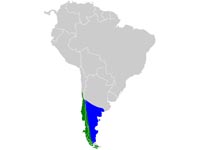

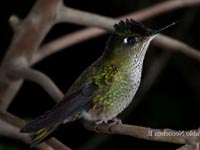


Firecrown,_Juan_Fernandez Sephanoides fernandensis Found: Robinson Crusoe Island of Juan Fernandez Archipelago, Chile
The male Juan Fernandez Firecrown has mostly cinnamon-orange plumage; dark gray wings; black bill; gold crown. Female has blue-green upperparts; blue crown; white underparts with some small green and black areas.
Image by: 1) Arthur_Grosset 2) Cornell_Univ's_Neotropical_Birds_Online - Fabrice_Schmitt 3) Héctor Gutiérrez Guzmán 4) d_robichaud - Chile1) Female 2 - 4) Male


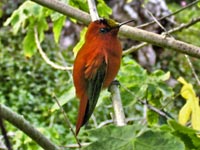

Comet,_Gray-bellied Taphrolesbia griseiventris Found: Peru
The Gray-bellied Comet has bronzy-green upperparts; long green tail feathers with orangeish tips; gray underpats. Male has blue throat. Female has shorter tail.
Image by: 1) Cephas 2, 3) Nick_Athanas 2) Female 3 Male
